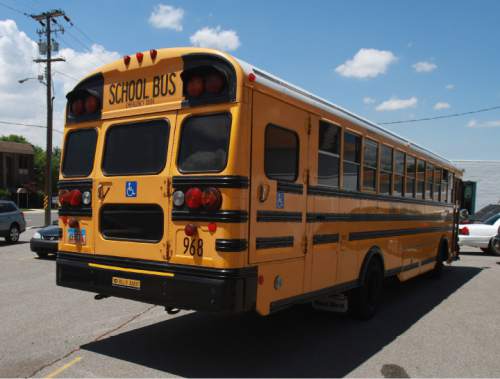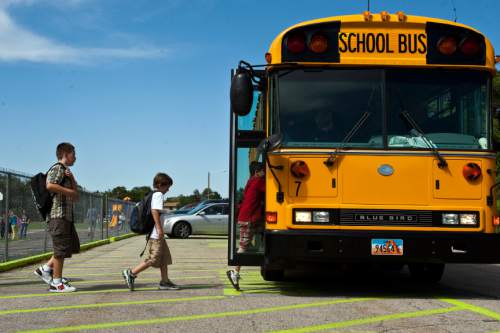This is an archived article that was published on sltrib.com in 2014, and information in the article may be outdated. It is provided only for personal research purposes and may not be reprinted.
The state's fastest-growing — and largest — school district has had trouble keeping up with maintenance on its buses.
A biannual inspection by the Utah Highway Patrol last month found 45 percent of Alpine School District's buses needed repairs. Some of the required work was serious enough to take the vehicles off the road.
Alpine's maintenance backlog surpassed that of all other Utah school districts.
Just six of Canyons District's 190 buses needed repair. In Salt Lake City, 9 of 97 buses had to be fixed. Roughly 10 percent of Granite School District's 170 buses needed service. And 17 percent of Jordan School District's 234 buses required fixes.
Alpine, in Utah County, has had the highest rate of required repairs in the state for seven of the past nine inspections — essentially for four and a half years. District officials say they will beef up the district's transportation department to address the safety violations.
District spokesman John Patten said that a seventh mechanic will be hired and administrators are looking at additional ways to invest in the aging fleet.
Alpine enrolls 2,000 new students each year, Patten says, and that growth rate puts a strain on transportation resources.
"I think it's a direct byproduct of the growth, that we do have an aging bus fleet and we would say, very forthrightly, this is something that needs our attention," he said.
School district buses are inspected twice each year by the Utah Highway Patrol, Sgt. Jason Kelsey said, including a full fleet inspection in the fall and a spot check of roughly 20 percent of buses in the spring.
During Alpine's most recent inspection in October, 265 buses were inspected and 120 were determined to be in need of repair, Kelsey said.
Alpine has another 37 new buses that were inspected before the district took ownership.
Buses were flagged for issues ranging from obstructed emergency exits to fuel- and brake-line leaks, Kelsey said. The required repairs were serious enough to order the buses out of service.
"There's definitely a different threshold for when we're going to tell them they cannot transport people on the bus," he said.
Kelsey said most inspections result in roughly 10 percent of a district fleet ordered out of service.
A similar fleet inspection last month in Canyons School District found 3 percent of its buses in need of repair, according to district spokeswoman Jennifer Toomer-Cook.
Jordan School District had to repair 39 out of 234 buses, district spokeswoman Sandra Riesgraf said.
Patten said Alpine's transportation department did a repair "blitz" following the inspection and was able to have all of its buses back in service within 72 hours. The inspection came shortly before classes were let out for fall break, Patten said, allowing time to repair the buses without interrupting service to students.
"By the time school was back in session on Tuesday, all the buses were totally up to snuff," he said.
In Jordan, Riesgraf said district mechanics were able to repair all but one bus on the day of the inspection. The district employs 10 mechanics to maintain its fleet. In some cases, the district was dinged for missing emergency decals on the interior of buses or for exterior advertisements that covered up reflective siding.
"We welcome these kinds of inspections," Riesgraf said. "It never hurts to have another set of eyes because this is the most precious cargo that we have that these buses are carrying."
But one Salt Lake City school board member said the annual inspection process isn't enough and needs to be revamped to ensure the safety of students.
"If [school districts are] not meeting the standards on their own, we're jeopardizing the lives of our students," said Michael Clara, a member of the Salt Lake City Board of Education.
Clara said greater oversight of the state's school bus fleets is needed. He is working with state lawmakers to draft legislation after being disappointed by the response to service needs in his own district last summer.
"There has to be more enforcement," Clara said, "because in my district there was nobody there to compel them."
Clara argues that the Utah Highway Patrol, or another state agency, should be able to demand that repairs are made and follow up with school districts.
School district have failed to police themselves, he said, and some punitive measures are required to ensure that minimum standards and service needs are met.
"That's the kind of rigor I'd like to see," he said.
Inspections right now carry no punishment, Kelsey said. Utah Highway Patrol typically does not review repairs between the fall and spring inspections. But the agency maintains contact with school districts throughout the year.
"We do have an ongoing relationship where we speak with their mechanics and the transportation director," he said.
Patten said Alpine bus drivers conduct a daily inspection of their vehicles before picking up students and were aware of some issues with the fleet. The highway patrol inspection highlighted some of those concerns while also revealing other service needs that were not yet known to drivers.
"We see ourselves in a partnership with the same goal of safely transporting kids," he said.





